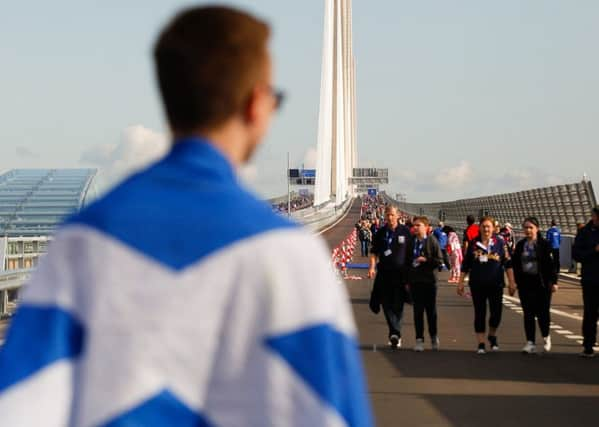Brian Monteith: Bridges have no nationality


It would be chauvinistic to claim the bridges as purely a Scottish achievement. While the Forth Bridge is held as the greatest ever man-made Scottish icon it was designed by two English engineers, Sir John Fowler and Sir Benjamin Baker, rather like the Englishman Frederic Weatherly composed Danny Boy after his Irish-born sister gave him the tune of Londonderry Air.
My favourite bridge in the world, I recall travelling over it by steam train with my grandma to visit her relatives in Arbroath aged four. I was in awe as we crossed the bridge that my grandfather (and her husband) worked on as a bridge inspector for British Railways.
Advertisement
Hide AdAdvertisement
Hide AdThe shape, the colour, the size, the height the of the viaducts to reach and leave its cantilevers and the massive granite towers the steel rests upon – all of it comes together like a divine cocktail of engineering and mathematical ideas to produce a heady mix.
Construction commenced in 1882, was completed by 1889 and opened in 1890, representing the peak of technology in its time. It was the first great steel structure in Britain, made possible after Henry Bessemer, another Englishman, patented his process of mass steel production. This in turn was improved upon by the German-born Sir William Siemens and Frenchman Pierre-Émile Martin. By comparison the Eiffel Tower, built in the same period, was made from wrought iron.
The steel came from Wales, Glasgow and Motherwell and the viaducts were designed separately by Scotsman James Carswell, also responsible for Queen Street Station’s glass roof. Of course the navvies that built the bridge, including the 73 that died, were from many countries.
Likewise the Forth Road Bridge – which I remember being opened live on telly and receiving a Royal Mail First Day Issue from my granny – was not a solely Scottish affair. Designed by British engineers Mott, Hay and Anderson (responsible for the Tyne and Trent bridges and Mersey Tunnel) and Freeman Fox & Partners (responsible for the Sydney, Severn, Humber and Bosporus bridges) – both firms were based in London and its construction was jointly managed by companies from Glasgow, Darlington and Middlesbrough.
Advertisement
Hide AdAdvertisement
Hide AdI was always a keen supporter of a new bridge across the Firth of Forth, writing about it on these pages before today’s politicians got behind it. Anyone could see the Forth Road Bridge was struggling to cope with the traffic demand that had gone from a design limit of 11 million vehicles a year to 23 million by 2006.
The Queensferry Crossing is no different in its international flavour; built by a multinational consortium of Spanish, German, American and British construction companies and designed by a Danish, Swedish and British engineers – it then used Chinese steel to save money. It truly is a global feat of excellence.
Oh, and thanks to the fiscal transfer of funds from England to Scotland to balance the books of our SNP government it is also fair to say English taxpayers made their own not inconsiderable contribution to the bridge. But then, like those bridges over the Severn, Humber and Tyne, the Queensferry Crossing is part of the UK’s road network too. “Better Together”, I recall was the claim, and it still holds true.
So next time, when there’s a similar big engineering achievement in Scotland, rather than hand out Saltires, why not hand out the flags of all the nations that made it possible? After all, bridges are about crossing what divides us, not beating our chest with false pride.